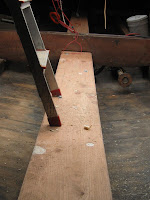 When it has to do with 30-year old wood preserved beneath 30 annual layers of red copper and thick oil-based paints, sandblasting sounds about as wise a choice as taking a chain saw to the old keel, which is to say, the skipjack was sandblasted this week.
When it has to do with 30-year old wood preserved beneath 30 annual layers of red copper and thick oil-based paints, sandblasting sounds about as wise a choice as taking a chain saw to the old keel, which is to say, the skipjack was sandblasted this week.The sandblasting was done by a "boat skinner," agree the captain Jack Russell & builder of the Dee, Francis Goddard. Goddard finished with the chain saw work a couple weeks ago. http://justbeforeitsgone.blogspot.com/2010/06/merging-regs-and-zen-of-boat-building.html
Robert Knott beneath minimal gear -- earplugs only after an on-site supervisor passed them out -- peeled the paint off the starboard hull of the Dee of St. Mary's in two hot days.

The restoration now moves into inch-by-inch work. Today shipwright Ben Goddard works alone beneath the boat boring and drilling, adding and replacing long screws at precise angles into particular spots into the stripped starboard hull.
The skipjack had been tilted the day before the sandblasters arrived to expose more of the starboard bottom. This requires adjustments to the array of jacks balancing the skipjack's perch on land. This particular adjustment requires a slight lowering of the port jacks then slight hoisting of starboard jacks, then lowering again of the port jacks, raising the starboard's, and on and on until your heart just can't take it anymore.
Jack roars a dismissal of my foolish question, "What if it falls?"
"That boat will almost stand on its feet," he said. "You've just got to be slow with it."
(no endorsement of any other YouTube videos are made .... blogger.com just has issues with direct uploads .... this is just a disclaimer)







